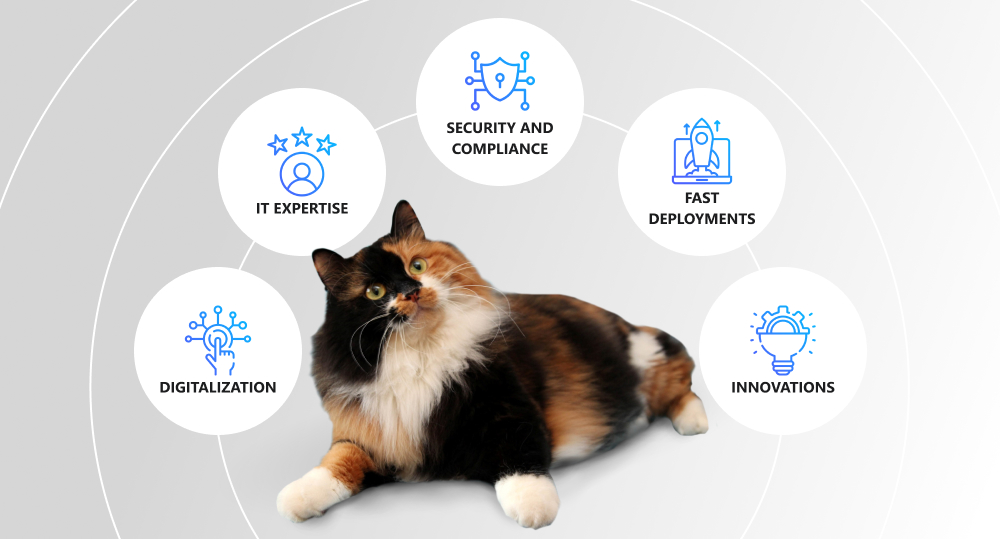Did you hear that the digital lending platform market is skyrocketing today? According to the latest Grand View Research report, the market was valued at $5.84 billion in 2021 and the specialists are expecting it to grow at a CAGR of 25.9% from 2022 to 2030. So, it's high time to turn to lending as a service and be ready for modernization. It won’t take long to find yourself in the world without traditional lending so rich in unnecessary human interventions, physical interactions at every step, and long processing time.
There is no point in explaining more benefits at this stage. Check our comprehensive review of trends and tendencies in the LaaS industry.
WRITTEN BY:
Alexander Arabey
Director of Business Development, Qulix Systems
Contents
What Makes Lending as a Service Stand Out
First, we should note that Lending as a Service (LaaS) is one of the novice players in the upfront fintech industry. Why did it take a longer path to the market? You may find the answer in the field of rigorous compliance requirements that were common across lending around the globe. Meanwhile, the growing acceptance of Open Banking API standards, cloud-based infrastructure, and other innovations set the route for the expansion of LaaS solutions integrated into the broader BaaS (Banking as a Service) ecosystem.
For example, in Japan the digital lending service market was estimated at 15.7 billion Japanese yen in 2020. By 2024, it is expected to reach 26.4 trillion yen.
So, what is so special about it? In a few words, LaaS enables banks and lenders to surface their services outside of their established banking channels (online banking apps or traditional branches). In simple English, a LaaS platform provides marketplace lending solutions to get closer to wider audiences.
Furthermore, LaaS equips banks, retailers, and other businesses with software to provide their customers with additional options for financing. With LaaS providers, companies get extensive support in risk assessment, funding, and underwriting, accompanied with a brand of a loan-originating partner. These platforms provide technology to brands as opposed to giving funds to clients.
Is Your Lending Digital Enough?
Now let us see what lays underneath the technology of digital lending and what solutions supply LaaS platforms. There are three key components which form an iterative process of seamless digital lending where the previous stage enables the following one.
Digital Channels
They are used for servicing. The range of digital channels include mobile and web applications, integrated solutions, email, SMS, and others. These channels allow customers to apply for loans, receive disbursements, and search for the info at any convenient time and place.
Digital channels collect customer data (with the customer’s consent) and enable the next essential component.
Digital Data
It is used for customers' credit and behavior assessment. It collects data from relevant data sources like credit scores, bank statements, or credit bureau data to understand whether a given customer is able to repay. This prediction can be significantly boosted by applying Machine Learning algorithms.
What is more, lenders utilize the data for further personalized targeted communications, new lending product offerings, and promotions.
Customer Experience
The final stage activates outstanding customer experience: from your clients' perspective it looks like super quick loans. The modern banking tech provides self-service loan applications, loan approval in almost no time, and much faster disbursal.
LaaS Platforms: Why You Need Them
With LaaS solutions lenders get a number of advantages. What are they? Here is our top five list of benefits.
Boosted Digitalization
There is still a long journey to take before financial institutions can get rid of manual paper-based processes. Only 5% of banks from all over the world finished their digital transformation in 2021 as it was discovered by Forrester Consulting.
LaaS can dramatically boost digitalization and bring end-to-end lending together, automate processes, streamline workflows, or decline loan origination times. It provides lenders with the access to cutting-edge technologies like Artificial Intelligence and Machine Learning.
IT Expertise without Overhead
When you decide to build in-house custom software solutions, you should be ready that it can cost you an arm and a leg. You will have to hire teams of IT experts, data scientists, testers, security professionals, and other specialists.
A LaaS platform reduces your expenditures for decisioning, acquisition, and loans servicing. And you don't have to pay for computing power you don't really need as processing capacity of LaaS platforms can easily be adapted to your requirements.
Security and Compliance Assistance
There are not many industries that can compete with financial services in the amount of compliance, security, and governance controls.
LaaS providers design their solutions with the full awareness of strict industry regulations. You don't have to worry about bank-level encryption, KYC, or other compliances.
Fast Deployments
LaaS solutions are a cost-effective and timely alternative to struggling with an overhaul of core banking systems like verification processes, mortgage origination, loan origination systems, and others. They help avoid risks of over-emphasis on planning or rollout timelines.
You can quickly unlock required services right on the platform and they will be managed by your LaaS provider.
Start for Innovations
It is essential for financial services to be prepared to adapt to changes without any timelogs and difficulties. LaaS providers enable lenders with promising access to the latest technological solutions to add new features on the go.
For example, with low-code drag-and-drop options your team can launch products and services almost lightning fast.
Some LaaS Providers to Mind in 2022
As the digital lending environment keeps on evolving, many LaaS providers create winning partnership models for banks, traditional lenders, retailers, and other financial institutions to help them leapfrog into the digital age.
We have handpicked four platforms you should check out in 2022.
Finflux
It is a SaaS embedded lending platform where you can find integrated features for core lending processes like loan origination and management, marketplace integration, dashboards, reporting, and many more.
Finflux serves a range of businesses from SMBs and business correspondents to banks, fintechs, and aggregators.
Its customers value extensive reporting options, excellent UI, and careful customer service. On the other hand, some of them wish to have more flexibility for bulk operations, and better performance quality of the platform.
Sageworks Lending
Sageworks Lending and Credit software by Abrigo helps financial institutions reduce loan origination expenses and overcome lending inefficiencies. The software also replaces data silos with automated processes to pave the way to insights, and provide space for future growth.
The clients set a high value on platform integration solutions for a range of lending modules. They also appreciate powerful built-in reporting writers and excellent customer service. But Abrigo's Sageworks Lending software works only with US banks, and the platform requires quite a lot of internal resources to operate efficiently.
FIS Commercial Lending Suite
FIS Commercial Lending Suite solutions can be tailored to the requirements of a broad array of businesses from small-to-medium enterprises to multinational corporations. So, you can choose a complete loan process plan or just specific modules.
The customers think much of the platform's customizable options and advantageous interface. At the same time, the company operates only in the US market, and some clients complain about occurring errors in data provided.
LoanPro
LoanPro provides core lending software which focuses on servicing of loans. They aim to empower financial services with the technology for bringing lending innovations to life.
The platform is built on its own API and can be integrated into your existing software. LoanPro unifies the entire loan lifecycle and you can create and service several lending products in one place.
Its users admit intuitive and robust APIs, flexible cloud solutions, and modern UI. However, some of them find its interface a bit clunky, and the software also requires some professional configuration before you can use it.
Lending as a Service: Prospects and Expectations
We are also ready to look into the future and make suggestions on what will push fintech lending ahead. So, here are the top forces in our opinion.
Focus on New Audiences
Traditional banks have had a limited view on business loans for a long time. If your company had less than 2 years of revenue you would have to struggle to find a lender.
Today, you can turn to BigTechs like Amazon or PayPal for working-capital loans or equipment financing. They make instant decisions and approvals based on your payment or revenue-generating history data.
One more vast segment of previously ignored audience includes freelancers, creators, and gig workers who used to stay away from traditional lending. Now, their cash flows start being covered through alternative innovative lending products.
Mainstream of Embedded Credit
You can find embedded credit in the form of the Buy-Now-Pay-Later option on the majority of eCommerce sites.
You will find the button to cover the purchase amount right in the checkout form. Also, you can check your eligibility before making a purchase.
So, for many retailers Lending as a Service seems a universal solution to meet their customers’ needs.
New Gens Rule
Younger generations are taking advantage of shopping apps and fintechs with enhanced user experience and no-fee restrictions. There is little chance that they would eagerly turn to traditional banks.
That is why new gens are a powerful driving force of the digital lending shift. Today it mapped over to providing loans for cars and homes. For example, at Rocket Mortgage you can apply within minutes and with minimal documentation.
AI & ML Fuel
It is hard to underestimate the unique insights capabilities of artificial intelligence and machine learning algorithms for the lending industry. Fintech lenders can benefit from better underwriting criteria for lending models and lower risk of defaults. Advanced AI models will help companies reduce operating costs and force up growth.
In a Nutshell
So, fintech has become a guiding light for businesses worldwide in their race towards endless possibilities and emerging development. And Lending as a Service is a significant contributor to the progress.
LaaS platforms enable your business with digitalization and innovation potential, boost your company's security and effectiveness. And trends like embedded lending and AI & ML follow the demands of latter-day audiences.
We believe that LaaS will ride the crest of a wave like BaaS, SaaS, and other cloud-based technologies.
Why not start your lending project right away? At Qulix Systems, we are ready to consult you about our top-notch Fintech Software Development services and discuss various cooperation options. For more details, please get in touch with our support team.

Contacts
Feel free to get in touch with us! Use this contact form for an ASAP response.
Call us at +44 151 528 8015
E-mail us at request@qulix.com











